

Employee training and development is an essential aspect of any organization. It helps employees acquire new skills, improve job performance, engagement and contribute to the growth of the organization.
However, the success of training programs depends on it’s design, delivery, and evaluation. As organizations continue to invest in employee training, measuring and improving the training effectiveness becomes crucial.
In this blog, we will explore the concept of training effectiveness, its importance, and various factors that contribute to making training programs effective.

Training effectiveness refers to the extent to which a training program achieves its desired objectives, goals and produces the desired outcomes.
It measures whether the training program has been successful in helping employees acquire new knowledge, skills, and attitudes and apply them to their jobs.
An effective training program should result in improved employee performance, increased productivity, engagement at the same time curb absenteeism and turnover rates to achieve better business outcomes.
Training effectiveness is influenced by several factors, like design, delivery of the training program, the relevance of the training content to the job, the level of employee engagement and participation, and the organization’s support for the training program.
Measuring training effectiveness helps organizations determine whether their training programs are achieving their intended objectives and identify areas for improvement and as expected, give maximum return on investment.
The Kirkpatrick Model was developed by Dr Robert E. Kirkpatrick, who worked as a professor at Harvard Business School. He later became the dean of the school. His research focused on organisational learning and measuring the training effectiveness of programs.
The Kirkpatrick Model consists of four levels of evaluation to measure training effectiveness: Level I (reaction), Level II (learning), Level III (behaviour) and Level IV (results). Each level has its criteria, and each level is vital for measuring training effectiveness and improving training programs.

Reactions are the first step in any learning process. When people learn something new or receive feedback about their work, they tend to have certain feelings. These feelings can range from confusion to joy. Some people may even feel angry if they don’t understand what they are taught.
When people react to training, they must make sense of the information they’ve been given. They need to determine whether this new knowledge will help them perform better. For example, when someone receives feedback that they need to improve their communication skills, s/he must decide if these skills will help them succeed in their job. If not, then s/he should try to improve other areas of their performance.
Learning occurs when people apply new knowledge to solve problems. People use this knowledge to complete tasks more effectively. To increase their learning ability, people must practice and reflect on what they learned.
Learning involves two steps: internalisation and application. Internalisation means that learners become aware of the new knowledge. Application refers to applying new knowledge to solve real-life problems.

There are three types of learning: explicit, implicit and experiential. Explicit learning is when people learn by reading books, watching videos, listening to lectures, etc., while implicit learning happens when people gain knowledge without consciously thinking about it. Experiential learning is when people learn through activities such as role-playing, practising, performing, etc.
Behavioural changes occur after people have completed training programs. The behaviours that change most often involve interacting with others, which includes communicating with customers, working with colleagues, meeting deadlines, making presentations, etc.
Behavioural changes usually take place over time. However, some behavioural changes happen immediately after training. After completing a training session, employees might be able to answer questions faster than before.
After completing a face-to-face training program, participants might start acting differently. For instance, they might begin smiling more or talking less.
Results are the final stage in the learning process. At this point, people know how to apply what they have learned. They also know how well they performed during different parts of the training session.

Results are measured using evaluations. Evaluations include questionnaires, interviews, observations, tests, etc.
Evaluation methods depend on the type of training you’re conducting. For example, you may want to evaluate your training sessions for content, delivery style, etc. You may also want to conduct exit surveys, post-training interviews, etc.
Now that we have learned about the Kirkpatrick evaluation model, let’s comprehend why we must measure training effectiveness. What is the motive behind it?
When you start working at a new company or organisation, you want to get the most out of your training investment. How do you measure whether your training program is effective?
Organisations spend millions of dollars each year on training initiatives. Yet they often struggle to determine whether their training investments are paying off.
To answer this question, you’ll need to consider two key questions: What does training mean for your organisation? And, what should you expect from your training program?
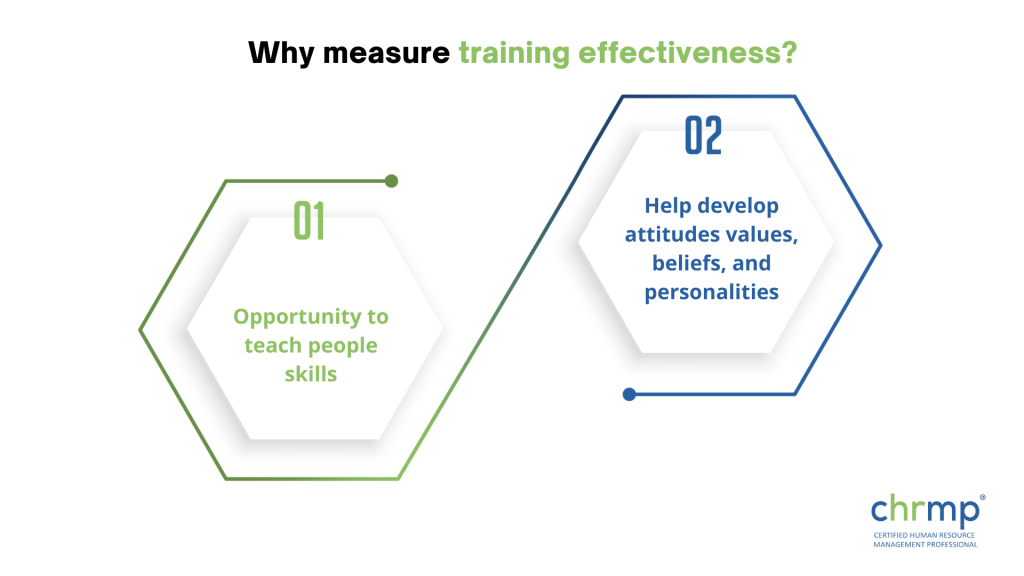
Training means more than just learning new skill levels.
Most organisations view training as an opportunity to teach people skills. But training can go much further than just teaching people new skills. It can help them develop attitudes, values, beliefs, and personalities.
For example, if you train someone to solve customer problems, he will likely become more empathetic towards his customers. He will also probably stop being so quick to judge other people based on their appearance.
If you don’t measure how well your training program works, you won’t know if it’s helping your organisation achieve its goals. So, how do you measure training effectiveness?
The first step is to understand what you want to learn. Then, you must identify the outcomes that matter most to your organisation. Finally, you must find ways to measure these outcomes.
To measure training effectiveness, you need to know what you are measuring. If you don’t see what you are measuring, then how will you be able to improve it?

1. Think About Outcomes Before Choosing Evaluation Methods
You can use any number of evaluation methods. The best way to choose which method to use is by thinking about the outcome you want to measure.
2. What Do You Want To Learn From Your Training Program?
Before choosing evaluation methods, consider what you want to learn from your training program, which includes improving employee performance and increasing sales revenue.
3. What Are Your Organisation’s Goals?
Once you’ve identified the outcome(s) you want to measure, you need to decide which evaluation methods are appropriate for achieving those results.
There are many different types of evaluation methods available. Some of the most common include:
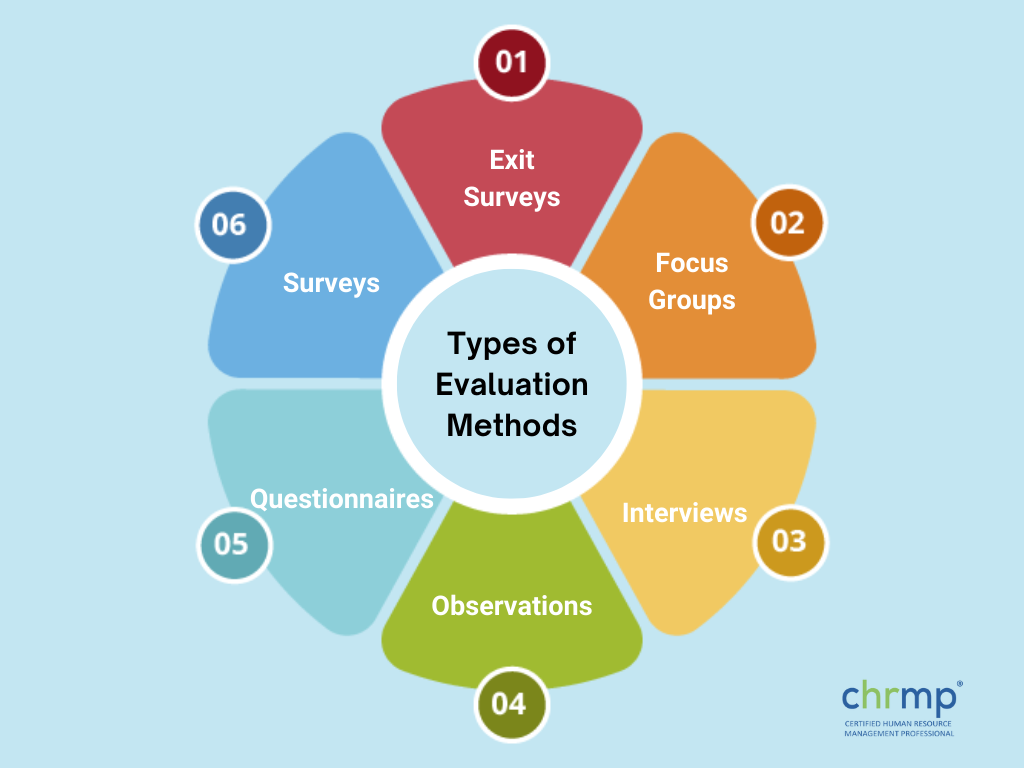
Surveys are one of the most popular training effectiveness evaluation methods because they are easy to administer and inexpensive. However, surveys have several limitations. For instance, there is no guarantee that all survey respondents will complete the study. Also, some people may not answer the questions honestly.
Let’s understand the training effectiveness evaluation metrics in detail.
Training evaluation metrics measure how well a training program has been implemented, including attendance rates, completion rates, and satisfaction surveys. The goal is to determine whether the training was successful.
Some organisations also use other measures, such as employee retention or turnover rates. These are called secondary measures. Secondary measures help you assess the impact of a training program on an individual level.
After deciding what you want to evaluate, you should consider the following factors when choosing evaluation methods:
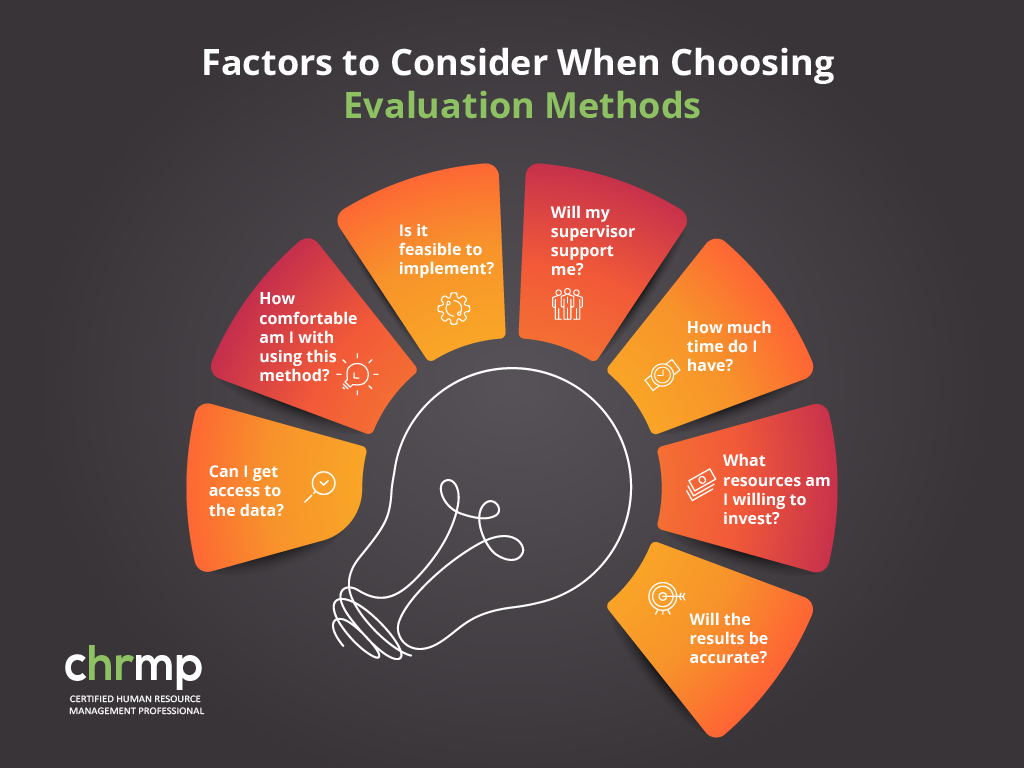
Evaluation metrics are measures of performance or training effectiveness. They provide objective evidence of whether or not a specific training program has produced desired results.
Training evaluation metrics are essential because they allow trainers to identify areas where their programs are lacking and focus on those aspects of the program that need improvement.
Choosing an effective evaluation method to measure training effectiveness depends upon your needs and objectives. You must first define the program’s goals to select the correct evaluation method. Then you can choose the appropriate evaluation method based on your needs.
There are many different types of evaluation methods available. Each type provides a unique perspective on the effectiveness of a training program.
The three main categories of evaluation methods to measure training effectiveness are:
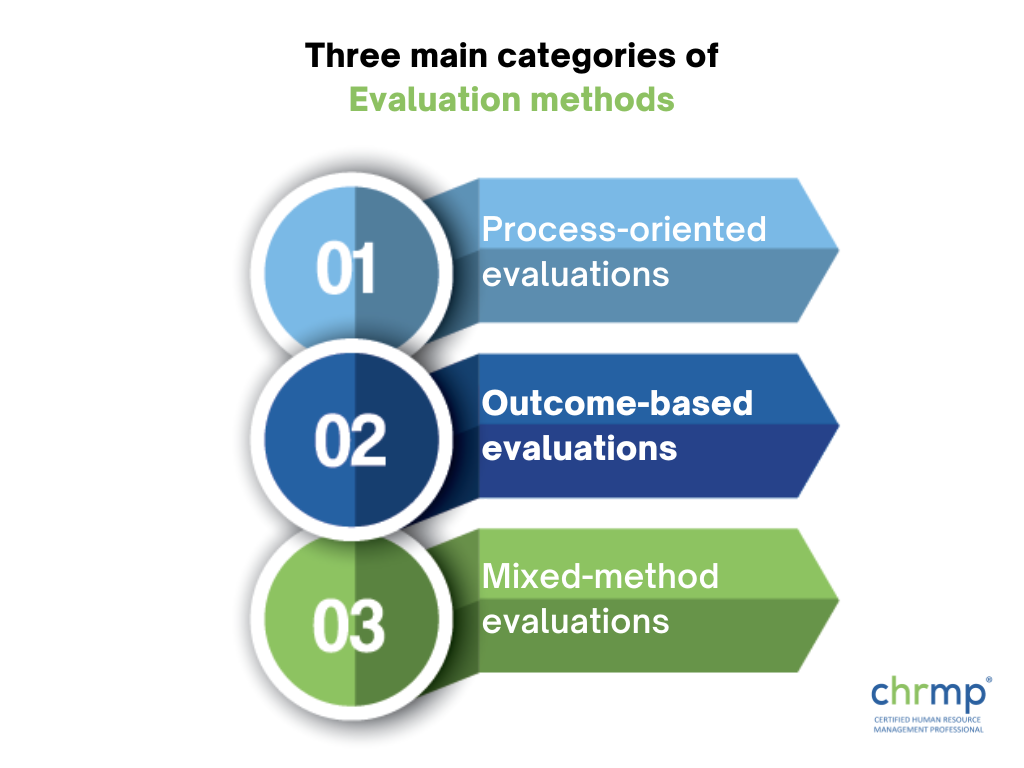
1. Process-Oriented Evaluations
These evaluations look at the process of implementing the training program, including attendance rates, participation rates, and satisfaction surveys (method).
2. Outcome-Based Evaluations
These evaluations focus on the outcomes of the training program. They include completion rates, knowledge tests, and job performance ratings (results).
3. Mixed-Method Evaluations
This category combines both process and outcome evaluations. It looks at the process of implementing a training program and its effects on participants’ knowledge and skills.
It would be best if you considered the following factors before selecting the best evaluation method to measure training effectiveness:
If you decide to use an evaluation method to measure training effectiveness, make sure that you follow these steps:
Here are some examples of standard evaluation methods to measure training effectiveness:
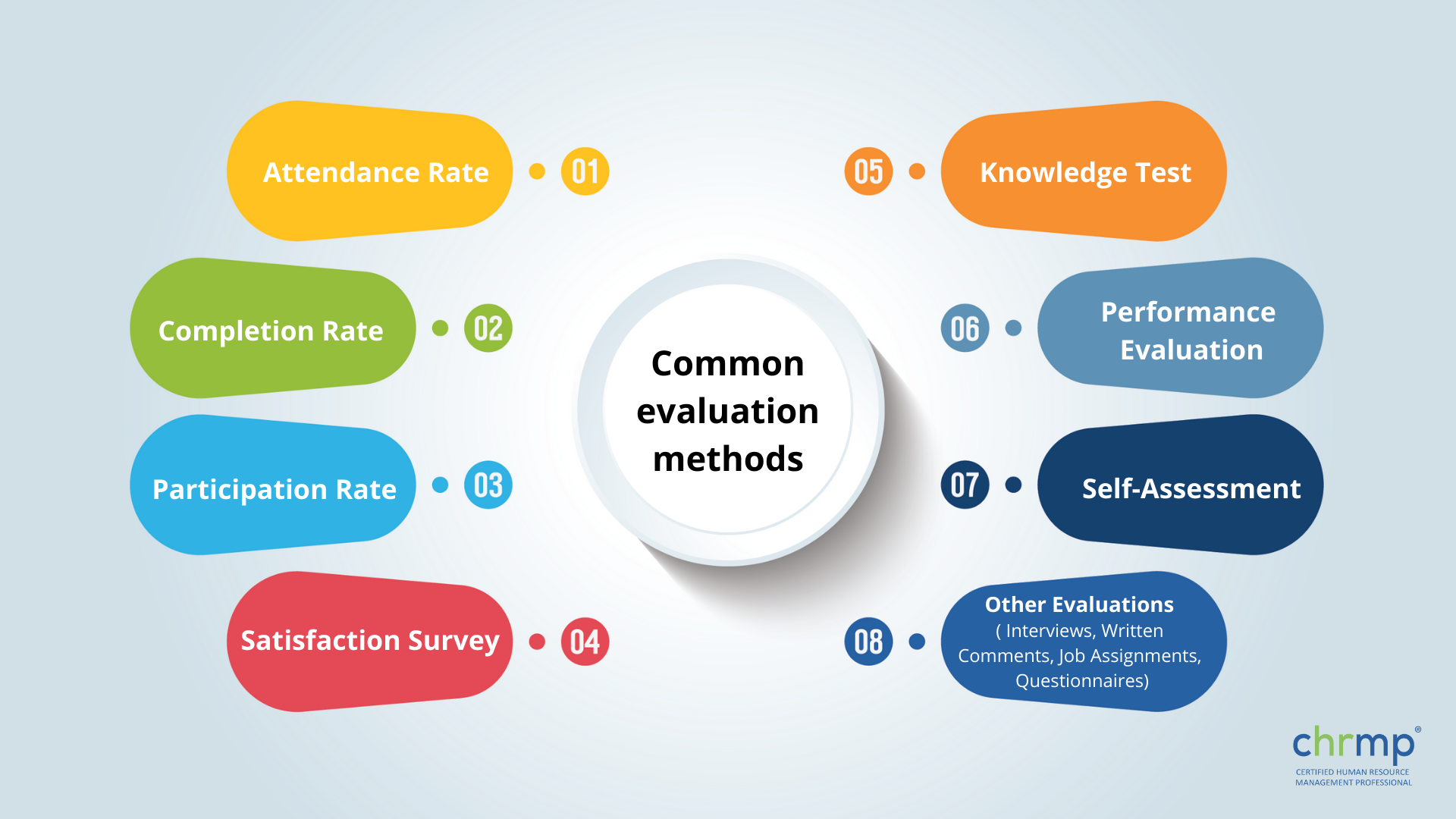
Attendance Rate
A simple way to evaluate the success of a training program is to count the number of people who attend the sessions. You do not need to ask anyone why they did not participate in. You may want to modify your evaluation criteria if you find out that specific individuals were absent because they had other commitments.
Completion Rate
In this case, you would determine whether or not a person has completed the entire course. The completion rate is calculated by dividing the total number of people who have completed the course by the total number of people enrolled.
Participation Rate
In this case, you would calculate the percentage of people who participated in the training program. The participation rate is calculated by dividing those who attended the training session by the total number of eligible people.
Satisfaction Survey
The most popular form of evaluation is a satisfaction survey. This evaluation asks participants to respond to questions such as “How satisfied are you with the training?” or “What aspects of the training program made it successful?” Participants can also provide comments if they feel so inclined.
Knowledge Test
Another effective method of evaluating training programs is to administer a test after the training. A knowledge test measures the extent to which participants learned new concepts during the training. In addition to testing participants’ knowledge, you might include questions about their attitudes toward the subject matter covered in training.
Performance Evaluation
This type of evaluation evaluates a person’s performance on specific tasks related to the training. Performance evaluations are usually conducted at regular intervals throughout the year. For example, you might give employees a monthly performance evaluation based on their attendance, participation, and job-related skills.
Self-Assessment
This type of evaluation focuses on the individual employee’s ability to perform his/her job duties. Self-assessments are typically done before and after the training. After the training, you might ask the person to complete an assessment questionnaire that includes items such as “To what degree was the training relevant to my current responsibilities?” or “Did I learn anything new that will help me perform my job more effectively?”
Other Evaluations
Many other types of evaluation methods could be used depending upon your organisation’s needs. Some of these include:
• Interviews – These interviews are often conducted after the training. They allow you to get feedback from the trainees regarding the training experience.
Written Comments – The trainee usually provides these written comments after completing a course. They allow you to gain valuable information regarding the training experience. It is essential to read all of the comments carefully because some may contain helpful information.
Job Assignments – You can use this method to evaluate the impact of training on job performance. You might assign specific jobs to different groups of employees. Then, you can compare the results of each group to determine whether the training affected the quality of work performed.
Questionnaires – You can use questionnaires to gather data regarding the training experience. The responses to the questionnaires should be analysed to identify problems and areas for improvement.
A company’s training metrics are essential for several reasons:
The metrics tell you whether your employees are learning effectively. If they aren’t, then you should change your training program. They also show you how well your employees perform compared to other employees. Finally, they let you know which areas of your business require additional attention.
A corporate training program should be measured using metrics such as the number of participants, completion rates, and ROI. These metrics help determine whether the training was successful and what changes need to be made for future programs.
Training evaluation metrics help you understand how practical your training was. The main goal of any training program is to increase employee knowledge and skills. There are several ways to evaluate whether your training has been successful. One way is to ask participants what they learned from the training. Another way is to use post-training surveys to determine which topics were covered well and which ones need improvement. A third option is to use pre-and post-test results to determine how much knowledge and skill improvements occurred after completing the training.
You can also use training evaluation metrics to assess the success of your training programs. For example, if you have a new product launch, you can survey before and after the launch to see how many people have heard about it, which helps you gauge the effectiveness of your marketing campaign.

You can also use training evaluation methods to compare your performance against your competitors. To do so, you must first establish a baseline measurement of your current level of training effectiveness. Once you’ve determined the baseline, you can measure your progress over time by comparing your results to those of previous years.
Finally, you can use training effectiveness evaluation metrics to make informed decisions about your training needs. For example, you may want to add more classes to your training schedule if you find that most of your employees don’t complete the courses. Or, you may reduce the time spent on certain subjects if you notice that most of your employees already know them.
Training evaluation is one of the most critical aspects of any corporate training program. It allows you to determine whether your training efforts have the desired effect. In addition, it lets you know where you can improve your training programs.
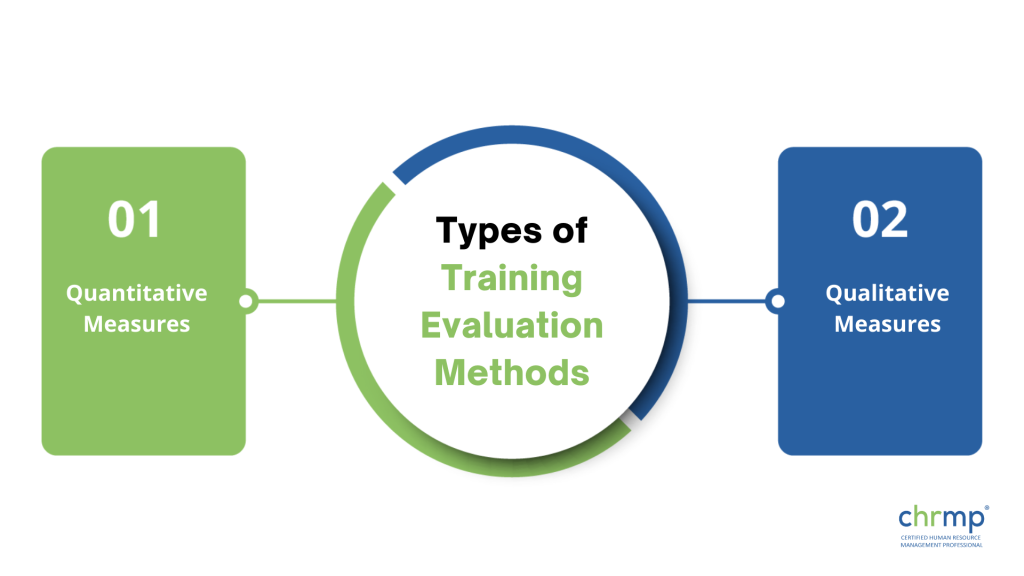
Using quantitative and qualitative measures is the best way to evaluate training effectiveness. Quantitative measures include attendance, completion rates, and test scores. Qualitative measures include feedback from participants and observations of their behaviour. You can then combine these two data types into an overall picture of your training’s effectiveness.
The following sections explain how to use each type of training effectiveness evaluation method.
Use quantitative measures when trying to determine training effectiveness. These measures include:
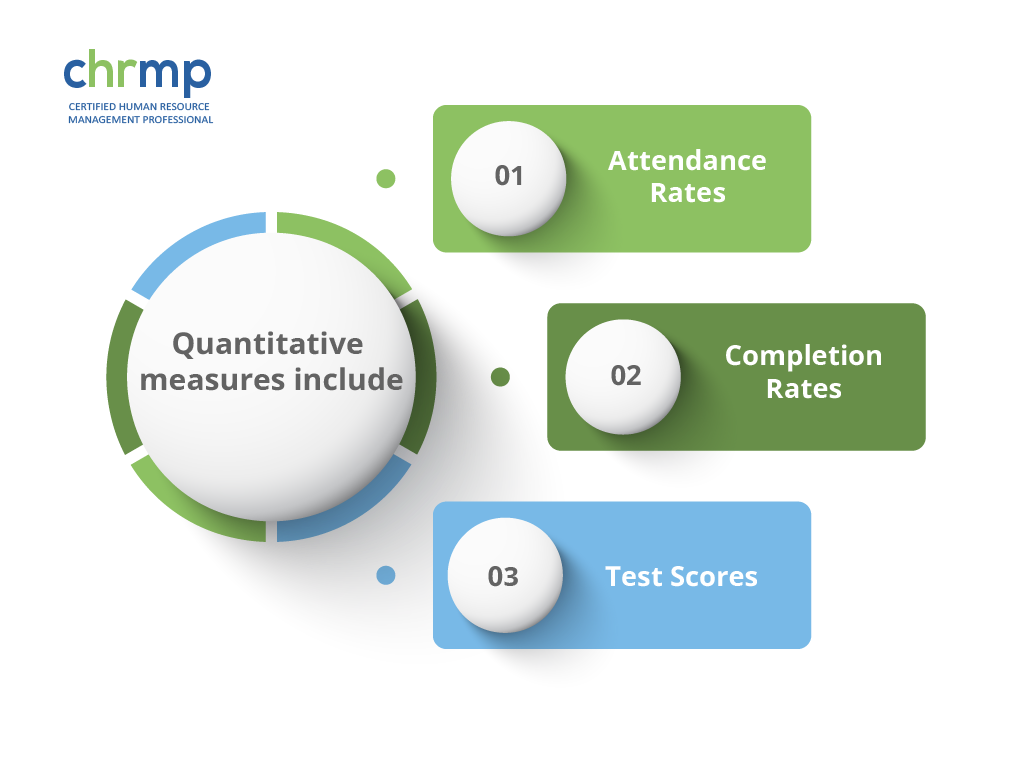
To calculate your attendance rate, divide the number of attendees at your training sessions by the total number of attendees who attended all of your training sessions. If you had 100 attendees for your entire training series, and only 50% completed the course, your attendance rate would be 0.5 (50%).
To calculate your completion rate, divide the number who completed your training by the total number of participants who took part in your training. If you had 100 participants for your entire training series and only 30% completed the course, your completion rate would be 0.3 (30%).
To calculate your test score metric, take the average of the test scores obtained by your participants. If you had 10 participants taking a quiz with a possible maximum score of 20 points, and they scored an average of 15 points, then your test score metric would be 15/10 1.5.
Use qualitative measures when you’re trying to determine training effectiveness of your corporate programs. These measures consist of:
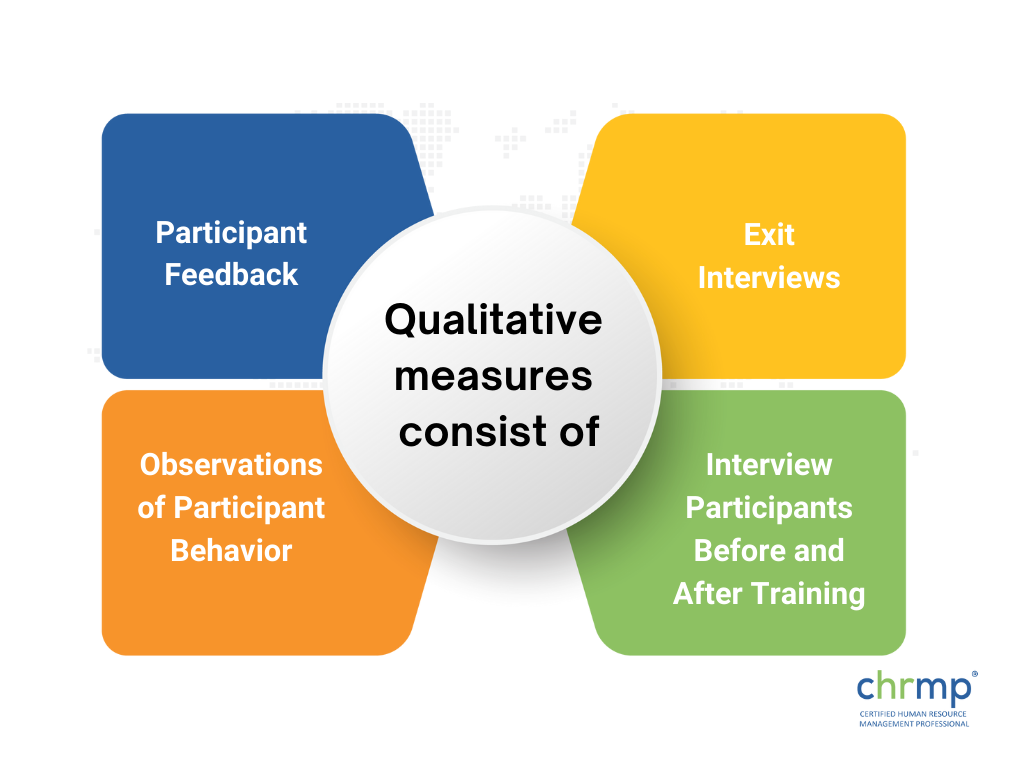
You can collect participant feedback through several different means. First, ask your participants about the training content or format, and observe their behaviour during class. Then, conduct exit interviews after class has ended—finally, interview participants before and after the course to get their impressions of the training experience.
You can also gather information about your participants’ opinions of the training through surveys. Survey questions should focus on the training topics, not general feelings toward the company. For example, if you were conducting a sales training session, you might ask questions like “How well did this training help you prepare for selling?” Instead of asking, “Do you like working here?” which could elicit negative responses.
During class, watch participants closely for signs of difficulty understanding the material. When they have problems, offer them additional time to complete the exercise or repeat it until they know it. Also, note whether they seem engaged or disengaged while listening to the trainer’s presentation.
After class, ask participants to fill out an exit survey, which helps them identify areas where they need more instruction. You may find that some people want more practice with a particular topic than others; therefore, you’ll know how much extra training they need.
Ask participants to complete a post-training questionnaire. The questions will vary depending on the type of training you’re providing. Questions such as “What was most helpful about today’s training?” and “Did anything surprise you about today’s training?” will give you insight into the strengths and weaknesses of your program.
It is essential to possess the ability to identify training KPIs. Let’s learn how to do that :
How do you measure the success of your training program? Is it enough to track attendance, or should you also look at other metrics, such as retention rates?
Training programs are essential for organisations looking to improve their performance. They provide employees with new skills and knowledge to apply to their jobs. In addition, they can boost employee morale and productivity.
Training programs are often measured using attendance records and surveys. These methods are helpful but don’t always tell the whole story. Attendance alone isn’t sufficient because it doesn’t consider whether the trainees learned anything from the course. Surveys are also problematic because they rely on self-reporting, which can be unreliable.
You must use multiple measurement tools to evaluate training effectiveness ensure that your training program is effective. Here are three ways to evaluate the results:
The first step in measuring training effectiveness is tracking attendance. If you simply count the attendees, you won’t get a clear picture of what happened during the training.
For instance, let’s say you hold a two-hour training session monthly. You expect 100 attendees each time. However, only ten people show up. What does that mean? It means that 90% of your attendees didn’t learn anything from the training.
You can solve this problem by asking attendees to complete a survey after the training. Survey responses help you determine if attendees understood the information presented during the training.
Another way to gauge training effectiveness is to calculate its retention rate. Retention refers to the percentage of attendees who return to attend future sessions. For example, 80% of attendees come back for subsequent classes, so you’ve achieved a high retention rate.
However, if 70% of attendees return for subsequent classes, your retention rate has dropped, indicating something wrong with your training program.
A third method for evaluating training effectiveness is to conduct exit surveys. Exit surveys are performed after the training session ends. Participants are asked to answer questions regarding the training session.
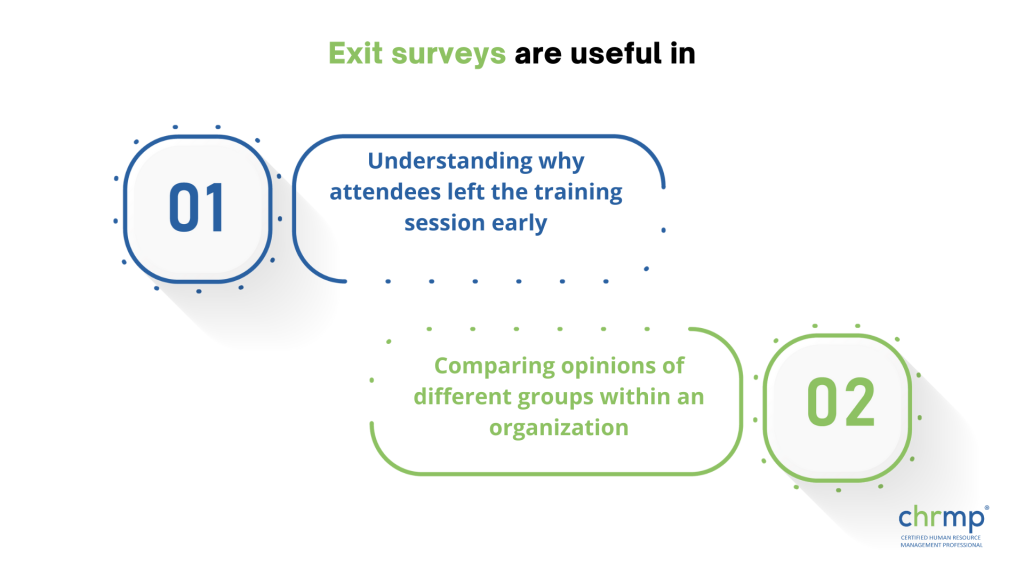
This approach helps you understand why attendees left the training session early. For example, if more than half of the attendees go after just 30 minutes, then you know that the content wasn’t interesting enough.
In addition, exit surveys allow you to compare the opinions of different groups within an organisation. For instance, you could ask attendees about their level of satisfaction with the training. Or you could ask them about their job responsibilities before and after attending the class.
These three approaches will give you a better idea of how well your training program works. If you want to ensure that your training program is as effective as possible, consider implementing all three techniques.
The answer depends on several factors, such as the size of your organisation, the type of employees you train, and whether or not you want to improve performance.
Training effectiveness is vital because it helps companies retain their top talent. In addition, it improves productivity, increases customer satisfaction, and reduces turnover.
An assessment tool can help you identify areas where your employees need improvement. This way, you can focus your training effectiveness efforts on those specific areas.
You’ll have to manually enter data into the system using a paper-based assessment tool. As a result, you may miss some key details.
An online assessment tool lets you collect data automatically. That way, you don’t have to spend hours entering data.
The best approach is to use both types of tools. For instance, you might start collecting data through a paper-based agency but switch to an online tool once you’ve collected enough data.
There are many ways to evaluate employee training effectiveness. However, not every assessment technique works for every situation.
For instance, some assessments work well when you want to see which parts of the training program participants liked most. Others work well when you want feedback on what they didn’t like about the training.
Other assessments work well when looking for information about the skills participants learned during the course. And yet others work well when you want information about the impact of the training on participants’ attitudes and behaviours.
You’ll need to do some research to find out which assessment methods work best to successfully evaluate training effectiveness in your company. You can start by interviewing other trainers who specialise in this area.
Once you’ve identified the suitable assessment method to measure training effectiveness in your company, you can decide which questions to include in each survey.
It would be best to determine how long you want to keep track of each individual’s responses. Some people prefer to look at only one year of data; others would like to examine five years’ worth of results.
You can conduct the same assessment multiple times throughout the year. You can ask new questions or add new categories to the existing questionnaire each time.
To get accurate results from your training effectiveness assessment, you must ensure that everyone completes the surveys consistently. You’ll need to provide clear instructions and follow up regularly to achieve this goal.
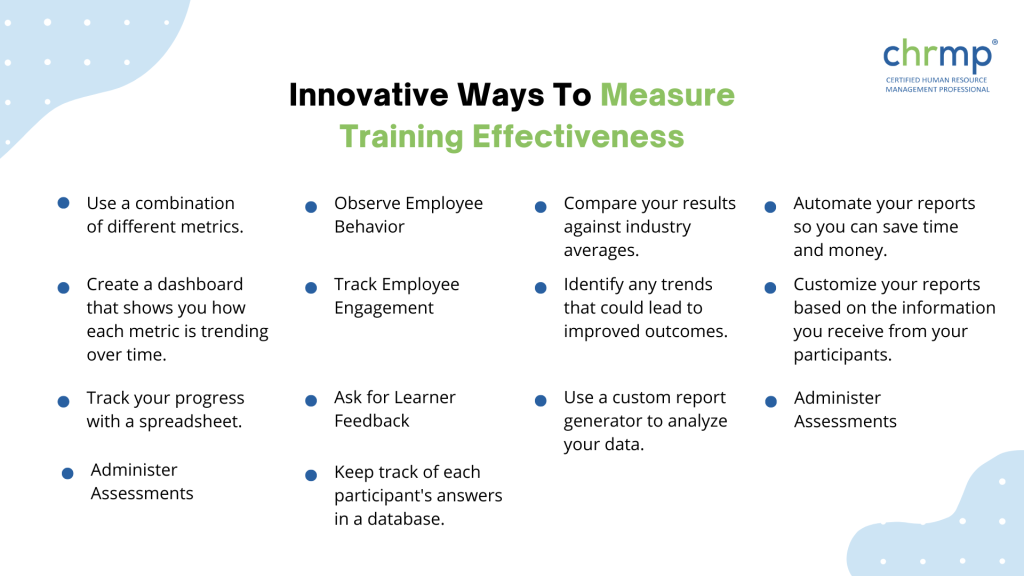
Let’s move on to the final stage.
Training is an essential part of any organisation. Whether it’s internal or external, training helps employees become better at their jobs. The question is, how do you know if training has worked?
There are several ways to measure training effectiveness, such as employee surveys, performance evaluations, and feedback from managers. This article discusses these methods and explains why each one is useful.
The first step toward evaluating training effectiveness is determining whether a particular training program was effective is to identify the goals you set for it. These goals should be specific enough to help you evaluate its success. In addition, you should have a way to compare your results against those of similar programs. For example, if you want to improve sales, you might use a comparison group of all other companies in your industry.
Next, you’ll need to gather data about the trainees’ experiences before, during, and after the course. If possible, you should collect data from both the trainees themselves and their supervisors.
If you’re using a self-assessment tool to measure training effectiveness, make sure you give yourself plenty of time to complete it. You may need to spend more than two weeks collecting data.
Once you’ve collected the necessary data, you can begin analysing it. Depending on the type of training you conducted, there are three main ways to evaluate training effectiveness of your program:
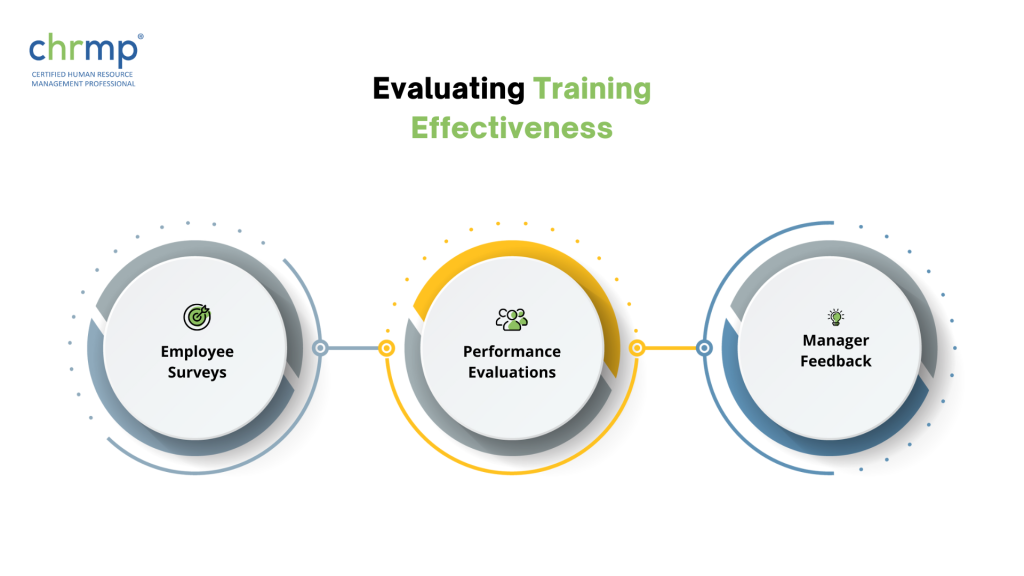
Each method provides slightly different insights into what went well and what didn’t. Let’s take a look at each one.
This approach involves asking employees to complete a questionnaire after finishing the course. It gives insight into which parts of the training were most valuable to the trainees.
You can also ask questions about the quality of the training materials, the instructor’s skills, and the overall experience.
You can conduct this survey either online or by mail. Online surveys are easier to administer but require more effort on your part. Mail surveys are less convenient but provide a much larger sample size.
A performance evaluation resembles an employee survey, except that it focuses on the trainees’ job performance rather than their satisfaction with the training.

Performance evaluations are usually done when the trainees return to work. They allow you to see how well the trainees performed on tasks related to the training.
You must carefully select the tasks used to gauge trainees’ performance to get accurate results. Ensure that the tasks are relevant to the training objectives and that the criteria you use to judge performance are appropriate.
When evaluating training effectiveness, it’s essential to consider the trainees’ opinions and those of their supervisors. After all, the supervisor ensures that the trainees successfully perform their jobs.
Managers often don’t know how to evaluate trainees’ performance effectively, making it difficult to determine whether the training has been successful.
To address this problem, many organisations now offer managers special training courses designed to teach them how to assess trainees’ performance.
When measuring the effectiveness of training programs, it’s important to consider various factors to ensure accurate and meaningful results. Here are five best practices for measuring training effectiveness:
By following these best practices, you can enhance the accuracy and effectiveness of your training evaluation process, leading to improved training programs and better-informed decision-making.
In conclusion, the best way to measure training effectiveness and ensure that your training program is effective is to combine several evaluation methods, which will give you a better idea of what worked and what didn’t.
Training is essential to any business. Without proper training, employees will lack the knowledge to do their jobs correctly. However, even the best training programs won’t be effective without careful planning and preparation.
Following these steps will ensure that your training efforts produce positive results.
Google Analytics is a free tool from Google that allows you to track how visitors use your website. The main features include traffic sources, demographics, site behaviour, conversion tracking, and search engine optimisation.
Issues in the training process and improve it
The HR department usually does the training process, which means they do not know what skills are needed for each position, which leads them to hire someone who has no experience in the field and then train them. As a result, the employee does not learn anything new, and the company loses money. To avoid these issues, the best thing to do is create a job description for each position and hire only candidates who meet all the requirements.
How often do you get stuck in a rut when working on projects? You start with a plan, but then you realise that you don’t know where to go from there, which always happens to me.
When working on a project, you should always have a clear idea of where you want to take it. If you don’t, you might waste a lot of time.
You should also consider the resources that you have at your disposal. For example, if you use a tool you haven’t used before, you might run into some problems.
How Much Sense does Measuring Training Effectiveness Make?
Measuring training effectiveness makes sense because it helps you understand how much you spend on training, what kind of training works best for your company, and which employees need additional training.
I hope you found this article useful.
FAQ 1: Why is it important to measure training effectiveness?
Answer: Measuring training effectiveness is crucial for several reasons. It helps organizations identify whether training programs are achieving their intended objectives, allowing them to make informed decisions about resource allocation. It also enables the identification of gaps in knowledge and skills, leading to targeted training interventions. Moreover, measuring training effectiveness helps determine the return on investment (ROI) of training initiatives and provides insights into program improvements, ensuring that training aligns with organizational goals.
FAQ 2: What are some key metrics to measure training effectiveness?
Answer: There are several metrics that can be used to measure training effectiveness. These include participant satisfaction ratings, pre- and post-training assessments to evaluate knowledge and skill acquisition, on-the-job performance improvement indicators, employee engagement and retention rates, and cost-effectiveness measures such as training cost per employee or per hour of training. By tracking these metrics, organizations can gain a comprehensive understanding of the impact of their training programs.
FAQ 3: What evaluation methods can be employed to measure training effectiveness?
Answer: Various evaluation methods can be used to measure training effectiveness. These methods include pre- and post-training assessments to gauge knowledge and skill improvement, surveys and questionnaires to gather participant feedback, observation and performance monitoring to assess on-the-job application of training, focus groups and interviews to capture qualitative insights, and analysis of business metrics to link training outcomes with organizational goals. A combination of these methods provides a holistic view of training effectiveness.
FAQ 4: How can training effectiveness be measured beyond immediate post-training assessments?
Answer: To measure training effectiveness beyond immediate post-training assessments, organizations can adopt strategies such as follow-up assessments conducted at regular intervals to assess knowledge retention, on-the-job observation and performance appraisals to evaluate skill application, feedback loops and coaching sessions to track ongoing development, and analysis of business metrics over time to identify performance improvements. These approaches provide insights into the long-term impact and sustainability of training.
FAQ 5: What are some best practices for measuring training effectiveness?
Answer: Best practices for measuring training effectiveness include establishing clear and measurable objectives, utilizing a combination of evaluation methods, collecting data at multiple points in time, engaging stakeholders throughout the process, and linking training outcomes to organizational goals. These practices ensure a comprehensive evaluation, improve the accuracy of results, and provide actionable insights for optimizing training programs.
© 2007-2025 CHRMP| All Rights Reserved | Powered by Ripples Learning & Research Private Limited
